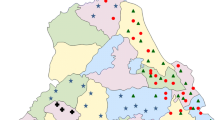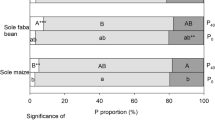Abstract
Phosphorus (P) is a primary limiting nutrient for crop production in weathered tropical soils. The deficiency is mainly caused by sorption of phosphate onto Al- and Fe- (hydr)oxides. We hypothesise that the distribution of soil P among various pools is influenced by land use. Our objective was to characterise the soil inorganic (Pi) and organic P (Po) pools and to compare the various pools at different depths in agroforestry (shaded) and monocultural (unshaded) coffee cultivation systems. The study was carried out in the Atlantic Coastal Rainforest domain, Brazil, with Oxisols as the dominant soil type. Soils were collected from four farmers' coffee (Coffea arabica L.) fields, two agroforestry and two monocultural systems. Three profiles were sampled per field, at depths of 2–3, 10–15 and 40–60 cm. A simplified sequential P fractionation was carried out, using resin, 0.5 M NaHCO3, 0.1 M NaOH, 1 M HCl and concentrated HCl as extractants. Sum-P (resin, NaHCO3 NaOH, 1 M HCl and concentrated HCl) ranged from 370 to 830 mg kg−1. Concentrated HCl extracted the largest portion (74%), followed by NaOH (22.5%). Labile (sum of resin, NaHCO3 and NaOH) P ranged from 13 to 40% of Sum-P. The major part (62%) of the labile fraction was Po. In the agroforestry fields, the amount of Po decreased less with depth and the percentage of Po in labile pools was higher than in monocultural fields. This suggests that agroforestry maintains larger fractions of P available to agricultural crops by influencing the dynamics of P through the conversion of part of the Pi into Po, thereby reducing P losses to the unavailable pools.
Similar content being viewed by others
References
Ae N., Arihara J., Okada K., Yoshihara J. and Johansen C. 1990. Phosphorus uptake by pigeon pea and its role in cropping systems of the Indian Subcontinent. Science 248: 477–480.
Agbenin J.O. and Tiessen H. 1995. Phosphorus forms in particlesize fractions of a toposequence from Northeast Brazil. Soil Sci. Soc. Am. J. 59: 1687–1693.
Beck M.A. and Sanchez P.A. 1994. Soil phosphorus fraction dynamics during 18 years of cultivation on a Typic Paleudult. Soil Sci. 34: 1424–1431.
Bolan N.S. 1991. A critical review of the role of mycorrhizal fungi in the uptake of phosphorus by plants. Plant Soil 134: 189–208.
Cardoso I.M., Guijt I., Franco F.S., Carvalho A.F. and Ferreira-Neto P.S. 2001. Continual Learning for Agroforestry System Design: University, NGO and farmer partnership in Minas Gerais, Brazil. Agric. Syst. 69: 235–257.
Cardoso I.M., van der Meer P., Janssen B.H., Oenema O. and Kuyper T.W. 2003a. Analysis of phosphorus by 31PNMR in Oxisols under agroforestry and conventional coffee systems in Brazil. Geoderma 112: 51–70.
Cardoso I.M., Boddington C.L., Janssen B.H., Oenema O. and Kuyper T.W. 2003b. Distribution of mycorrhizal fungal spores in soils under agroforestry and monocultural coffee systems in Brazil. Agrofor. Syst. (in press).
CFSEMG 1989. Recomendação para o uso de corretivos e fertilizantes em Minas Gerais, 4a aproximação. Lavras, Brazil, 176 pp.
Cooper P.J.M., Leakey R.R.B., Rao M.R. and Reynolds L. 1996. Agroforestry and the mitigation of land degradation in the humid and sub-humid tropics of Africa. Exp. Agric. 32: 235–290.
Cross A.F. and Schlesinger W.H. 1995. A literature review and evaluation of the Hedley fractionation; applications to the biogeochemical cycle of soil phosphorus in natural ecosystems. Geoderma 64: 197–214.
Dalal R.C. 1977. Soil organic phosphorus. Adv. Agron. 29: 83–113.
Fontes M.P.F. and Weed S.B. 1996. Phosphate adsorption by clays from Brazilian Oxisols: relationship with specific surface area and mineralogy. Geoderma 72: 37–51.
James D.W., Kotuby-Amacher J., Anderson G.L. and Huber D.A. 1996. Phosphorus mobility in calcareous soils under heavy manuring. J. Environ. Qual. 25: 770–775.
Hairston N.G. 1989. Ecological experiments. Purpose, design and execution. Cambridge University Press, Cambridge, 370 pp.
Lilienfein J., Freibauer A., Neufeldt H., Westerhof R., Ayarza M.A., Silva et al. 1996. Influence of land-use on the distribution of water stable aggregates and P status of sandy and clayey cerrado Oxisols, Brazil. In: Pereira R.C. and Nasser L.C.B. (eds), Biodiversity and sustainable production of food and fibers in the tropical savannas. Proceedings of the 1st International Symposium on tropical savannas. EMBRAPA-CPAC, Brasilia, Brazil, pp. 323–328.
Lilienfein J., Wilcke W., Ayarza M.A., Vilela L., Lima S.C. and Zech W. 2000. Chemical fractionation of phosphorus, sulphur, and molybdenum in Brazilian savannah Oxisols under different land use. Geoderma 96: 31–46.
Linquist B.A., Singleton P.W., Cassman and K.G. 1997. Inorganic and organic phosphorus dynamics during a build-up and decline of available phosphorus in an Ultisol. Soil Sci. 162: 254–264.
Magid J., Tiessen H. and Condron L.M. 1996. Dynamics of organic phosphorus in soils under natural and agricultural ecosystems. In: Piccolo A. (ed.), Humic Substance in Terrestrial Ecosystems. Elsevier, Amsterdam, pp. 429–466.
Neufeldt H., Silva J.E., da Ayarza M.A. and Zech W. 2000. Land-use effects on phosphorus fractions in Cerrado Oxisols. Biol. Fertil. Soils 31: 30–37.
Novais R.F. and Smyth T. 1999. Fósforo em solo e planta em condições tropicais. UFV/DPS, Viçosa, Brazil, 399 pp.
Resende M. 1997. O manejo do solo na agricultura sustentável. In: Almeida J. and Navarro Z. (eds), Reconstruindo a Agricultura. Porto Alegre, Brazil, pp. 253–288.
Rheinheimer D., Cassol P.C., Kaminski J. and Anghinoni I 1999. Fósforo orgânico do solo. In: Santos G.A. and Camargo F.A.O. (eds), Fundamento da matéria orgânica do solo: ecossistemas tropicais e subtropicais. Gênesis, Porto Alegre, Brazil, pp. 139–157.
Rice W.R. 1988. Analysing tables of statistical tests. Evolution 43: 223–225.
Richardson A.E.R. 2001. Prospects for using soil microorganisms to improve the acquisition of phosphorus by plants. Aust. J. Plant Physiol. 28: 897–906.
Robinson J.S., Johnston C.T. and Reddy K.R. 1998. Combined chemical and 31P-NMR spectroscopic analysis of phosphorus in wetland organic soils. Soil Sci. 163: 705–712.
Stewart J.W.B. and Tiessen H. 1987. Dynamics of soil organic phosphorus. Biogeochemistry 4: 41–60.
Szott L.T. and Melendez G. 2001. Phosphorus availability under annual cropping, alley cropping, and multistrata agroforestry systems. Agrofor. Syst. 53: 125–132.
Tiessen H. and Moir J.O. 1993. Characterisation of available P by sequential extraction. In: Carter M.R. (ed.), Soil sampling and methods of analysis. Canadian Society of Soil Science. Lewis Publishers, pp. 75–86.
Young A. 1997. Agroforestry for Soil Management. ICRAF and CAB International, Wallingford, 2nd ed., 320 pp.
Author information
Authors and Affiliations
Rights and permissions
About this article
Cite this article
Cardoso, I.M., Janssen, B.H., Oenema, O. et al. Phosphorus pools in Oxisols under shaded and unshaded coffee systems on farmers' fields in Brazil. Agroforestry Systems 58, 55–64 (2003). https://doi.org/10.1023/A:1025436908000
Issue Date:
DOI: https://doi.org/10.1023/A:1025436908000




